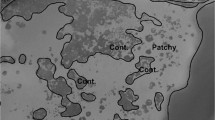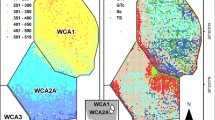Abstract
The plant communities in the Iles Kerguelen (South Indian Ocean) have been extensively modified by human activities, particularly through the deliberate release of rabbits, and the intentional or accidental introduction of several plant species. During the 1990 and 2000s, a decrease in precipitation resulted in a drastic reduction of some native plant species and in the increase in alien taxa. To monitor at a wide spatial scale the rapid changes of vegetation cover induced by summer droughts, we developed a method combining field data and satellite image analysis. A long-term field monitoring of plant communities was initiated on five small islands in 1992, and annually continued for over 15 years on a total of 161 line transects. Among these islands, the rabbit—which was the only introduced herbivore—was eradicated on three, remained on one control island, and had never been present on a second control island. We computed a linear model to link remote sensored vegetation indexes to plant cover deduced from line transects in numerous habitat types. After testing 14 vegetation indexes, we used a model based on the normalized difference vegetation index to precisely map the vegetation cover at several dates. A map of differences and spatial statistics indicated that vegetation cover, as a whole, decreased over the 15-year period. This study provides a reliable tool for long-term monitoring of the dynamics of plant cover in relation to climate change on the Iles Kerguelen.






Similar content being viewed by others
References
Beck PSA, Atzberger C, Hogda KA, Johansen B, Skidmore AK (2006) Improved monitoring of vegetation dynamics at very high latitudes: a new method using MODIS NDVI. Remote Sens Environ 100:321–334
Blackburn GA (1999) Relationships between spectral refectance and pigment concentrations in stacks of deciduous broadleaves. Remote Sens Environ 70:224–237
Breshears DR, Cobb NS, Rich PM, Price KP, Allen CD, Balice RG, Rommei WH, Kastensf JH, Floydk ML, Belnapl J, Andersonc JJ, Myers OB, Meyer CW (2005) Regional vegetation die-off in response to global-change-type drought. PNAS 102:15144–15148
Chapuis J-L, Boussès P, Barnaud G (1994) Alien mammals, impact and management in the French Subantarctic Islands. Biol Conserv 67:97–104
Chapuis J-L, Le Roux V, Asseline J, Lefèvre L, Kerleau F (2001) Eradication of the rabbit (Oryctolagus cuniculus) by poisoning, on three islands of the subantarctic Archipelago of Kerguelen. Wildl Res 28:323–331
Chapuis J-L, Frenot Y, Lebouvier M (2002) Une gamme d’îles de référence, un atout majeur pour l’évaluation de programmes de restauration dans l’archipel de Kerguelen. Rev Écol (Terre Vie) supplément 9:121–130
Chapuis J-L, Frenot Y, Lebouvier M (2004) Recovery of native plant communities after eradication of rabbits from the subantarctic Kerguelen Islands, and influence of climate change. Biol Conserv 117:167–179
Chen J (1996) Evaluation of vegetation indexes and modified simple ratio for boreal applications. Can J Remote Sens 22:229–242
Croll DA, Maron JL, Estes JA, Danner EM, Byrd GV (2005) Introduced predators transform Subarctic islands from grassland to tundra. Science 307:1959–1961
Donohue RJ, Roderick ML, McVicar TR (2008) Deriving consistent long-term vegetation information from AVHRR reflectance data using a cover-triangle-based framework. Remote Sens Environ 112:2938–2949
Forgeard F, Chapuis J-L (1984) Impact du lapin de garenne, Oryctolagus cuniculus, sur la végétation des pelouses incendiées de Paimpont (Ille–et–Vilaine, France). Acta Oecol 5:215–228
Frenot Y, Gloaguen J-C, Cannavacciuolo M, Bellido A (1998) Primary succession on glacier forelands in the Kerguelen Islands (Subantarctic). J Veg Sci 9:75–84
Frenot Y, Gloaguen J-C, Massé L, Lebouvier M (2001) Uman activities, ecosystem disturbance and plant invasions in subantarctic Crozet, Kerguelen and Amsterdam Islands. Biol Conserv 101:33–50
Frenot Y, Chown SL, Whinam J, Selkirk P, Convey P, Skotnicki M, Bergstrom D (2005) Biological invasions in the Antarctic: extent, impacts and implications. Biol Rev 80:45–72
Fretwell PT, Convey P, Fleming AH, Peat HJ, Hughes KA (2011) Detecting and mapping vegetation distribution on the Antarctic Peninsula from remote sensing data. Polar Biol 34:273–281
Fukami T, Wardle DA, Bellingham PJ, Mulder CPH, Towns DR, Yeates GW, Bonner KI, Durrett MS, Grant-Hoffman MN, Williamson WM (2006) Above- and below-ground impacts of introduced predators in seabird-dominated island ecosystems. Ecol Lett 9:1299–1307
Gitelson AA, Kaufman YJ, Merzlyak MN (1996) Use of a green channel in remote sensing of global vegetation from EOS-MODIS. Remote Sens Environ 58:289–298
Goel NS, Quin W (1994) Influences of canopy architecture on relationships between various vegetation indexes and LAI and FPAR: a computer simulation. Remote Sens Environ 10:309–347
Goward SN, Prince SD (1995) Transient effects of climate on vegetation dynamics: satellite observations. J Biogeogr 22:549–563
Hakvoort JHM, Heineke M, Heymann M, Kühl K, Riethmüller H, Witte R (1998) Optical remote sensing of microphytobenthic biomass: a method to monitor tidal flat erodability. Senckenbergiana Mar 29:77–85
Højsgaard S, Halekoh U, Yan J (2005) The R package geepack for generalized estimating quations. J Stat Softw 15:1–11
Huete AR (1988) A soil-adjusted vegetation index (SAVI). Remote Sens Environ 25:295–309
Huete AR, Liu HQ (1994) An error and sensitivity analysis of the atmospheric and soil-correcting variants of the NDVI for MODIS-EOS. IEEE Trans Geosci Remote Sens 32:897–905
Jiang Z, Huete AR, Didan K, Miura T (2008) Development of a two-band enhanced vegetation index without a blue band. Remote Sens Environ 112:3833–3845
Jonasson S (1988) Evaluation of the point intercept method for the estimation of plant biomass. Oikos 52:101–106
Jordan CF (1969) Determination of leaf area index from quality of light on the forest floor. Ecology 50:663–666
Katawa Y, Ueno S, Kusaka T (1988) Radiometric correction for atmospheric and topographic effects on landsat Mss images. Int J Remote Sens 9:729–748
Kelly AE, Goulden ML (2008) Rapid shifts in plant distribution with recent climate change. PNAS 105:11823–11826
Kidder JH (1876) Contributions to the natural history of Kerguelen Island, made in connection with the United States transit-of-vénus expedition, 1874–1875. Bull US Nat Mus 3:1–122
Laparie M, Lebouvier M, Lalouette L, Renault D (2010) Variation of morphometric traits in populations of an invasive carabid predator (Merizodus soledadinus) within a sub-Antarctic island. Biol Invasions 12:3405–3417
Lebouvier M, Laparie M, Hulle′A, Marais Y, Cozic L, Lalouette P, Vernon T, Candresse, Frenot Y, Renault D (2011) The significance of the sub-Antarctic Kerguelen Islands for the assessment of the vulnerability of native communities to climate change, alien insect invasions and plant viruses. Biol Invasions 13:1195–1208
Liang K-Y, Zeger SL (1986) Longitudinal data analysis using generalized linear models. Biometrika 73:13–22
Lymburner L, Beggs PJ, Jacobson CR (2000) Estimation of canopy-average surface-specific leaf area using Landsat TM data. PE&RS 66:183–191
Maron JL, Estes JA, Croll DA, Danner EM, Elmendorf SC, Buckelew SL (2006) An introduced predator alters Aleutian Island plant communities by thwarting nutrient subsidies. Ecol Monogr 76:3–24
Mulder CPH, Grant-Hoffman MN, Towns DR, Bellingham PJ, Wardle DA, Durrett MS, Fukami T, Bonner KI (2009) Direct and indirect effects of rats: does rat éradication restore ecosystem functioning of New Zealand seabird islands? Biol Invasions 11:1671–1688
Murray H, Lucieer A, Williams R (2010) Texture-based classification of sub-Antarctic vegetation communities on heard Island. Int J App Earth Obs Geoinformation 12:138–149
Mutanga O, Skidmore AK (2004) Narrow band vegetation indexes solve the saturation problem in biomass estimation. Int J Remote Sens 25:1–16
Nemani R, Pierce L, Running S (1993) Forest ecosystem process at the watershed scale: sensitivity to remotely-sensed leaf area index estimates. Int J Remote Sens 14:2519–2539
Pinty B, Verstraete MM (1992) GEMI: a non-linear index to monitor global vegetation from satellites. Vegetatio 101:15–20
Poissonet P, Poissonet J (1969) Etudes comparées des diverses méthodes d’analyse de la végétation des formations herbacées denses et permanentes. Conséquences pour les applications agronomiques. C.N.R.S.-C.E.P.E. Montpellier, doc. No. 50
Qi J, Chehbouni A, Huete AR, Kerr YH, Sorooshian S (1994) A modified soil adjusted vegetation index: MSAVI. Remote Sens Environ 48:119–126
Raynolds MK, Walker DA, Maier HA (2006) NDVI patterns and phytomass distributions in the circumpolar arctic. Remote Sens Environ 102:271–281
Rondeaux G, Steven M, Baret F (1996) Optimization of soil-adjusted vegetation indexs. Remote Sens Environ 55:95–107
Roujean JL, Breon FM (1995) Estimating PAR absorbed by vegetation from bidirectional reflectance measurements. Remote Sens Environ 51:375–384
Rouse JW, Haas RH, Schell JA, Deering DW (1973) Monitoring vegetation systems in the Great Plains with ERTS. In: Proceedings of the third ERTS symposium, 1, Washington, DC (US Gov. Printing Office), pp 309–317
Santin-Janin H, Garel M, Chapuis J-L, Pontier D (2010) Assessing the performance of NDVI as a proxy of plant biomass using non-linear models: a case study on the Kerguelen archipelago. Polar Biol 32:861–871
Sokal RR, Rohlf R (1995) Biometry, 3rd edn. Freeman, San Francisco
Vermote EF, Tanré D, Deuzé JL, Herman M, Morcrette JJ (1997) Second simulation of the satellite signal in the solar spectrum, 6S: an overview. IEEE Trans Geosci Remote Sens 35:675–686
Vernon P, Vannier G, Tréhen P (1998) A comparative approach to the entomological diversity of polar regions. Acta Oecol 19:303–308
Verstraete MM, Pinty B (1996) Designing optimal spectral indexs for remote sensing applications. IEEE Trans Geosci Remote Sens 34:1254–1265
Virtanen T, Mikkola K, Patova E, Nikula A (2002) Satellite image analysis of human caused changes in the tundra vegetation around the city of Vorkuta, north-European Russia. Environ Pollut 120:647–658
Vitousek PM, D’Antonio CM, Loope LL, Rejmanek M, Westbrooks R (1997) Introduced species: a significant component of human-caused global change. N Z J Ecol 21:1–16
Walther G-R, Post E, Convey P, Menzel A, Parmesank C, Beebee TJC, Fromentin JM, Hoegh-GuldbergI O, Bairlein F (2002) Ecological responses to recent climate change. Nature 416:389–395
Zhou L, Kaufmann RK, Tian Y, Myneni RB, Tucker CJ (2003) Relation between interannual variations in satellite measures of northern forest greenness and climate between 1982 and 1999. J Geophys Res 108(D1):4004. doi:10.1029/2002JD002510
Zuur AF, Ieno EN, Walker NJ, Saveliev AA, Smith GM (2009) Mixed effects models and extensions. In: Ecology with R. Springer, New York
Acknowledgments
This study was supported by the Institut Polaire Français Paul Emile Victor (IPEV program 136) and by the Centre National de la Recherche Scientifique (Zone Atelier de Recherches sur l’Environnement Antarctique et Subantarctique). This paper is part of the Scientific Committee on Antarctic Research Program EBA (Evolution and Biodiversity in Antarctica.). The SPOT data registered into 2002, 2009, and 2010 have been obtained with ISIS program (CNES). The authors thank M.W. Beck, I. Hogg, D. Piepenburg, B. Pisanu, M. Raynolds, and anonymous reviewers for providing constructive comments to improve and clarify the paper.
Author information
Authors and Affiliations
Corresponding author
Additional information
This article is an invited contribution on Global Tipping Points (Global Change and Antarctic Terrestrial Biodiversity) and part of the SCAR EBA programme. I. Hogg and D. Wall (Guest Editors).
Rights and permissions
About this article
Cite this article
Robin, M., Chapuis, JL. & Lebouvier, M. Remote sensing of vegetation cover change in islands of the Kerguelen archipelago. Polar Biol 34, 1689–1700 (2011). https://doi.org/10.1007/s00300-011-1069-z
Received:
Revised:
Accepted:
Published:
Issue Date:
DOI: https://doi.org/10.1007/s00300-011-1069-z




